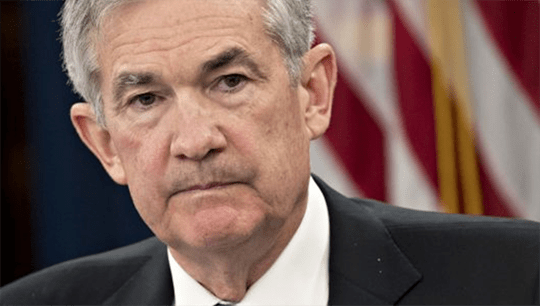EXPOSED: The Fed’s Deepest Secret
The announcement came issuing at 2 p.m. EST.
As roundly expected… Jerome Powell and his fellows sat idly upon their hands.
The fed funds rate remains chained in place, at 2.50%.
Mr. Powell, by way of explanation:
We think our policy stance is appropriate at the moment and we don’t see a strong case for moving in either direction. We say in our statement of longer-run goals and monetary policy strategy that the Committee would be concerned if inflation were running persistently above or below 2%.
The good chairman went on to dismiss last month’s weak inflation numbers as “transient.”
But is this the picture of “transience”?

Observe the trendline.
Where’s the (Official) Inflation?
Nearly 10 years on, the Federal Reserve pursues a grail agonizingly beyond its grasp — 2% inflation, sustained.
The latest data reveal March inflation increased only 1.6% year over year. January gave a reading of 1.8%.
Thus the Fed’s 2% target slips further beyond its outstretched fingers.
What — if any — credibility remains?
We can only cough sadly behind our hands, sink into our chair and look away in pity… as from a stage magician whose abracadabra has failed to conjure the rabbit.
So the time has come to expose the fraud sweating and writhing upon the stage… and reveal its deepest secret.
What is it?
To the answer we turn shortly. But first to the magic show on a parallel stage…
The Market Wanted a Rate Cut
The Dow Jones scraped along in positive numbers until word came down shortly after 2.
Upon which point it sank deeper and deeper into red, closing the day down 163 points.
Both S&P and Nasdaq followed nearly identical tracks.
The S&P ended the day 22 points lower; the Nasdaq 46.
Why the long faces on Wall Street?
The audience demanded a trick — a rate cut. And Mr. Powell failed to deliver.
Peter Boockvar, CIO of Bleakley Advisory Group:
“The market was pricing in this rate cut. They want a rate cut and this was basically Powell saying, ‘Sorry, but we’re not.’”
Not this time at least.
But to resume our exposé of the Federal Reserve… and its deepest secret…
The Federal Reserve Cannot Even Define Money
We begin with a premise:
The Federal Reserve can no longer define money. That is correct. It cannot even define money.
Imagine a butcher who cannot cut you a pound. Imagine a map maker who cannot measure a mile.
Now you have the flavor of it.
Under the Coinage Act of 1792, a dollar equaled one Spanish milled dollar — containing “371 grains and 4/16th parts of a grain of pure, or 416 grains of standard silver.”
Under the classic gold standard a dollar was defined as 1/20th of one ounce of gold. It was later defined as 1/35th of one ounce of gold.
But once old Nixon scissored the dollar’s final golden tether… the dollar defied all measurement.
It was as if 2.54 centimeters no longer defined an inch but a mile. Twelve inches no longer defined a foot but an inch. Three feet no longer defined a yard but a mile.
Perhaps you define a dollar as 100 cents. Well then, what is a cent? 1/100th of a dollar. But what again is a dollar?
And so you embark upon an infinite chasing of your tail.
We must conclude that today’s money is largely abstraction — wispy as gossamer, slippery as eels, elusive as quicksilver.
It is measured by a warring arrangement of alternate “money supplies” — none of which meet full requirements:
Unit of account, medium of exchange… store of value.
Alan Greenspan Comes Clean
Thus the Federal Reserve steers by the swaying and erratic lights of M0, M1, M2, MZM, etc.
Here we have money, near money, money at second and third remove, money somewhere in the ghostly ether.
And so the monetary authority cannot heave forth a working definition of money… or its true supply.
But do not rely upon our slanted word.
This we have on the authority of the maestro himself — Alan Greenspan — who confessed nearly 20 years previous that:
The problem is that we cannot extract from our statistical database what is true money conceptually…
One of the reasons, obviously, is that the proliferation of products has been so extraordinary that the true underlying mix of money in our money and near money data is continuously changing…
While of necessity it must be the case at the end of the day that inflation has to be a monetary phenomenon, a decision to base policy on measures of money presupposes that we can locate money. And that has become an increasingly dubious proposition.
Two decades, a great financial crisis and multiple rounds of QE later, the proposition has grown more dubious yet.
What and where is money? Where is inflation?
As notes Jeff Snider of Alhambra Investments, wryly:
“If you can’t ‘locate’ money, you can’t locate inflation.”
A Basic Definition of Money
We would argue that it is located in the asset classes — equities, real estate, etc.
But let us cleave to the simplest definition of money as defined by the late “Austrian” school economist Murray Rothbard:
The thing that all other goods and services are traded for, the final payment for such goods and services on the market.
True money is the “final” payment, that is. Only this money satisfies all obligations, retires all debts.
Economists of the Austrian School crafted a metric they labeled the “true money supply” (TMS) in the 1970s and ’80s.
Existing measures of money supply gave distorted readings, they claimed.
The true money supply consists of cash, demand deposits (i.e., checking accounts) at banks, savings… and government deposits at the Federal Reserve.
That is, it consists of money immediately available for transaction.
The TMS broad money supply is therefore more restrictive than the Federal Reserve’s broadly defined M2, for example.
March 2018 to March 2019, the official M2 money supply expanded 3.8%.
But TMS-2 year-over-year growth speaks a different tale…
Year-over-year TMS-2 money supply expanded a mere 2.2% in March, says analyst Michael Pollaro — its slowest pace in 12 years.
And preliminary data indicate year-over-year TMS-2 expansion has slipped to 1.7% in April.
That is, by the narrow TMS-2 reading, money supply is expanding at a far lesser clip than official M2.
Might this vast discrepancy explain the soft inflation data as officially presented?
An Arresting Conclusion
We cannot say for certain — we are not a credentialed member of the professional economics guild.
Thus we lack all official standing.
Might the theory wobble, might it stagger before an onslaught of evidence?
It may very well.
Then you can add it to the existing list of quack theories.
But the fact remains:
Nearly 10 years on, the Federal Reserve cannot work a sustained 2% inflation.
After long, hard pummeling of our cerebral centers, thus do we arrive at this arresting conclusion, the Federal Reserve’s deepest secret:
The Federal Reserve exerts little actual control upon the monetary system.
More tomorrow…
Regards,
Brian Maher
Managing editor, The Daily Reckoning



Comments: